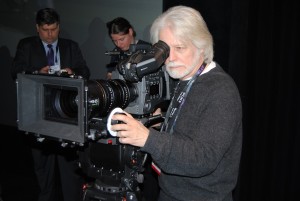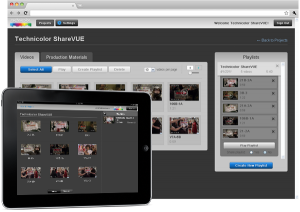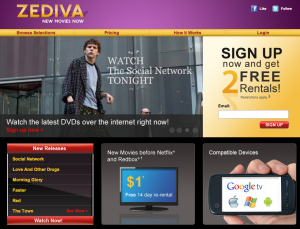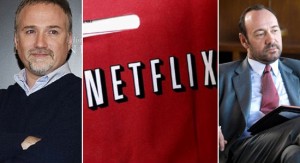
By
Rob ScottApril 12, 2011
Sony unveiled its new F65 CineAlta digital motion picture camera at an NAB press conference in Las Vegas this week. The F65 camera features a 20.4 megapixel, Super 35mm CMOS sensor, a significant jump from the F35’s 12.4 megapixel 1080p CCD. Is this another step away from film as a motion picture medium?

Pictured on the left is Curtis Clark (ASC) who directed a 4K short with the new camera, that is being shown at NAB.
According to Engadget: “…this sensor is fast — not only can it capture up to 72fps on 4K, but it can also crank up to a smooth 120fps on 2K. As for those seeking to squeeze out every bit of detail from their clips, don’t worry: the F65’s got you covered with a 16-bit RAW output (19Gbps) at 4K resolution, or it can be compressed to 5Gbps for the convenience of recording onto the new SR-R4 portable 4K recorder. Looks like Sony’s finally found a candidate that’ll put a lid on film stock, but then again, at the end of the day it’ll depend on the price tag when it comes out in Q3 this year.”
Sony also announced 2 new professional 3D cameras at NAB (and for consumers, the company announced the 3D Handycam and 3D Bloggie cameras at January’s CES).
Read the Sony Blog report on the NAB unveiling: “Sony Kicks off NAB with the announcement of a new 4K professional camera” (4/11/11)
Related Engadget post: “Sony shoots out CineAlta F65 4K camera and PMW-TD300 3D camcorder at NAB” (4/11/11)
The Photography Bay write-up includes video coverage of the NAB press conference and behind-the-scenes footage with Curtis Clark directing a 4K short with the new camera.

By
Rob ScottApril 12, 2011
Pelican Imaging announced its prototype “array camera” for mobile devices that uses multiple lenses to record a single high-quality image. The company hopes this will appeal to manufacturers who want to make a slimmer smartphone, and to users interested in leveraging computational imaging (adding features such as the ability to alter focus after an image has been captured).
 The three-year old company has received $17 million in venture funding. Its technical advisory board includes Marc Levoy, who co-designed the Google book scanner and helped launch Google Street View; Shree Nayar of Columbia’s Computer Vision Laboratory; and Bedabrata Pain, who co-invented active pixel sensor technology for mobile phone cameras.
The three-year old company has received $17 million in venture funding. Its technical advisory board includes Marc Levoy, who co-designed the Google book scanner and helped launch Google Street View; Shree Nayar of Columbia’s Computer Vision Laboratory; and Bedabrata Pain, who co-invented active pixel sensor technology for mobile phone cameras.
“Pelican’s technology has the potential to upset the traditional tradeoff between the sensitivity and resolution of a camera and its thickness,” Levoy said, adding “Pelican’s solution is small, fast and inexpensive — which makes it a very exciting technology.” According to Nayar, the technology is a “paradigm shift in imaging and video” likely to “bring computational imaging applications to the mass market.”
Check out this Engadget post to see a video about observing a scene with multiple cameras through synthetic aperture photography.
Related CNET article: “Pelican shows slim phone-camera prototype” (2/9/11)
For more information, visit the Pelican press release.

By
Rob ScottApril 11, 2011
GoPro is gaining in consumer popularity thanks to its collection of Hero Camera mounts that allow users to attach inexpensive cameras to everything from ski helmets to the tips of surfboards for action footage. Already popular with skiers, snowboarders, surfers, bikers and other outdoor enthusiasts and extreme athletes, the GoPro line is starting to become more common with professional cameramen as well. Nature photographers, in particular, are using GoPro products to shoot footage of hard-to-reach places, such as inside a cobra’s den or a shark’s mouth.
 The small, six-ounce, 1080p camera comes with a water-tight housing and starts at $260.
The small, six-ounce, 1080p camera comes with a water-tight housing and starts at $260.
GoPro’s parent company, Woodman Labs Inc., is receiving funding from outside investors, including Steamboat Ventures, a venture capital fund backed by Disney (Steamboat Ventures was also an investor in Pure Digital, maker of the popular Flip pocket camcorder). Steamboat plans to help GoPro expand further into the professional market.
Gizmodo offers a positive review of the 3D Hero System — a $99 3D kit (cameras not included) that GoPro bills as “the world’s smallest 1080p 3D camera.” The system combines two HD cameras in a waterproof housing that enables users to shoot synchronized photos and video (2D and 3D) that can then be edited in 3D with the free CineForm Studio software.
Most helmet and similar cameras have gone to wide angle lenses to ensure footage and minimize shake. The result was effective, but made things look smaller when viewed. Gizmodo notes that “adding 3D gives depth to the trees and objects rushing past you,” providing for a more immersive viewing experience.
You can check out the GoPro video demo to see how the 3D Hero System works.
Related Wall Street Journal story: “Camcorder Popular With Surfers Looks to Ride Professional Market” (4/6/11)

By
Rob ScottApril 10, 2011
Technicolor announced its next-generation secure, cloud-based dailies solution for film and television studio clients. According to the press release, ShareVUE enables remote viewing, collaboration and sharing of dailies content on HTML5-supported web browsers, iOS and Android devices. Technicolor explains it is working with the Squeeze Solution Pack encoding technology from Sorenson Media to implement cloud-based scalability.
 ShareVUE features include:
ShareVUE features include:
— A central hub to remotely view production materials while sharing time-stamped comments and playlists.
— A single encode that is transcoded and optimized “behind-the-scenes” to maximize visual quality for each supported device.
— Streaming-only model ensures media security, and includes content protection protocols combined with link encryption protocols, content scrambling and dynamic watermarking techniques.
Related Variety article: “Technicolor, Canon pact for cinematographers” (4/5/11)

By
Rob ScottApril 10, 2011
According to the YouTube Blog, the popular video site has officially launched its beta version of YouTube Live — the possible next step in turning YouTube into a competitive TV streaming site. YouTube has live streamed concerts, sporting events and interviews in the past, but YouTube Live has the potential to be something much more significant that could grab the attention of broadcasters, advertisers and social media experts.
 The blog announcement explains: “With over 2 billion views a day, it’s easy to think about YouTube as a place to watch videos recorded in the past. But you’ve told us you want more — and that includes events taking place right now…”
The blog announcement explains: “With over 2 billion views a day, it’s easy to think about YouTube as a place to watch videos recorded in the past. But you’ve told us you want more — and that includes events taking place right now…”
Although the announcement does not include the special celebrity channels touted in the press of late or any mainstream content yet, it does describe some basic information such as a browse page of live and upcoming events, interaction with users’ customized pages for channel subscription alerts, and YouTube’s plans for a “gradual rollout” of the live streaming beta platform.
The potential success of YouTube partners streaming live from their own channels may largely depend on the amount and type of content, as well as the social interaction between users and fellow streamers. However, it is clear that with the YouTube Live platform in place, Google is setting the stage for bigger ticket items, such as “broadcasting” professional content and global news and events.
Related Digital Trends article: “YouTube Live debuts as its overhaul continues” (4/8/11)
Related Wall Street Journal article: “YouTube Recasts for New Viewers” (4/7/11)
By
Rob ScottApril 10, 2011
Michael White took over the reigns of DirecTV the beginning of this year as the new president and CEO. During a recent three-day retreat with senior executives, White outlined the company’s strengths and weaknesses, and shared his vision for future growth, especially in regards to possible expansion in Latin America and reaching out to customers who use mobile devices. Investor’s Business Daily reports that DirecTV “is the world’s largest pay TV services provider with more than 28 million subscribers in the U.S. and Latin America.”
White emphasized that DirecTV is in excellent shape, but that an effective strategic plan would help steer the company into the future. His immediate focus is on recent deals with AT&T and Verizon that allow DirecTV to sell broadband services over fiber networks, the next phase of DirecTV’s recently launched free iPad application, and expanding the number of customers in Latin America (currently at 9 million).
“I was convinced that Latin America was still the best growth opportunity, and we should really expand more aggressively in Latin America,” White said. “In the U.S., we had a terrific core business, but we needed to address the ‘anytime, anywhere’ TV evolution and we needed some other revenue growth opportunities to help drive the top line while we were wrestling with higher programming costs.”
DirecTV’s first iPad app has some interesting features, yet is somewhat limited in its functionality for those truly on-the-go. It can serve as a remote control to change channels, browse channels without interrupting what’s on TV at the time, record to a DVR, and create a home screen with access to favorite channels. Users can use the app outside the home to schedule programs, but cannot currently use it to view programming. This may be the biggest obstacle for mobile device enthusiasts. White explains that phase two will enable users to import DVR content that has already been recorded to the iPad for remote viewing.
White says that DirecTV’s strategy to increase market share in Latin America involves a segmented approach by focusing on the quality of HD and DVR offerings — in addition to offering lower-priced packages, specifically targeting the middle-class who have so far been reluctant to take the plunge with paid services.

By
Rob ScottApril 10, 2011
We recently reported that Time Warner Cable had drawn significant controversy over its free live-streaming app that provides subscribers access to streaming television content via their iPad (only in their homes). AP reports that Time Warner Cable has bowed to the subsequent pressure from Fox Cable Networks, Viacom and Discovery — and will drop 12 cable channels from the app (20 channels will remain and Time Warner Cable suggests it has plans to add more). The three programmers had complained that the app violated their programming contracts.
 “For the time being, we have decided to focus our iPad efforts on those enlightened programmers who understand the benefit and importance of allowing our subscribers — and their viewers — to watch their programming on any screen in their homes,” explained Time Warner Cable in a statement.
“For the time being, we have decided to focus our iPad efforts on those enlightened programmers who understand the benefit and importance of allowing our subscribers — and their viewers — to watch their programming on any screen in their homes,” explained Time Warner Cable in a statement.
Since the AP story hit the wires, Time Warner Cable and Viacom announced they are countersuing each other in U.S. District Court. This case may be an important indicator regarding the growing debate over content and licensing rights amidst an era of mobile devices.
Related Los Angeles Times article: “Time Warner Cable and Viacom sue over iPad app” (4/8/11)
Related Forbes article: “Viacom Yanks Channels From iPad App, Raises Stakes In Streaming Standoff” (4/8/11)
Related Broadcasting & Cable article: “TWC Clicks iPad App Channel Count up to 73” (4/25/11)

By
Rob ScottApril 10, 2011
David Pogue of the New York Times writes that we are in a fascinating transitional period from physical media to streaming services, but that accessing streaming movies from our TVs, laptops and phones comes with a price. For example, we are missing some of the DVD features including subtitles, multiple languages and director’s commentary. We are also restricted regarding when we have access to some streaming content and how long our subscription or per-title fee allows us to view a specific title.
 In response to these concerns, Pogue mentions a new streaming service named Zediva.com that provides subtitle, language and commentary options in addition to some surprising (and perhaps disturbing, for the content creators and distributors) business model features. Rented movies are available for two weeks instead of 24 hours, current titles are available the same day as DVD releases, and there are no hardware or subscription fees — simply a rental charge of $2 per movie.
In response to these concerns, Pogue mentions a new streaming service named Zediva.com that provides subtitle, language and commentary options in addition to some surprising (and perhaps disturbing, for the content creators and distributors) business model features. Rented movies are available for two weeks instead of 24 hours, current titles are available the same day as DVD releases, and there are no hardware or subscription fees — simply a rental charge of $2 per movie.
The process is simple. Zediva has set up hundreds of DVD players in its California data center; the company purchases dozens of copies of current releases and makes them available to consumers. As Pogue writes: “The DVD is simply sending you the audio and video signals, as if it were connected to your home with a really, really long cable.”
Of course, content creators and distributors may have issue with this approach. In related news, the MPAA has filed a lawsuit against Zediva (since Pogue’s article), claiming that the company is violating copyright law by streaming DVDs. While the company bills itself as a movie-rental service, comparing its service with companies like Netflix that purchase hundreds of copies of popular movies and then mailing them to renters, the MPAA’s lawyers argue the service is a form of “public performance” that would require a license.
Related Wall Street Journal article: “Hollywood Studios Sue Start-Up Zediva” (4/4/11)

By
Rob ScottApril 10, 2011
Netflix has taken another big step forward in offering premium content, following its announcement that it will have exclusive rights to stream 26 episodes of the original series “House of Cards” starting in late 2012. The Internet streaming service outbid cable channels such as HBO and AMC. “House of Cards” is a political drama based on the 1990 BBC miniseries of the same name. The new production will star Kevin Spacey; David Fincher is tapped to direct.
 The deal is a big move for Netflix, which traditionally only airs previously produced and aired content. For the first time the company is licensing content before it is successfully produced. “Typically, we license TV shows the season after they run on a broadcast network or cable channel, and occasionally we have episodes from a current season, as is the case with ‘Saturday Night Live’ from NBC, ‘Spartacus’ from Starzplay and ‘Wizards of Waverly Place’ from Disney Channel,” Chief Content Officer Ted Sarandos wrote on the Netflix blog. “In all of these cases, the shows are produced before we bring them to Netflix. ‘House of Cards’ represents a slightly more risky approach.”
The deal is a big move for Netflix, which traditionally only airs previously produced and aired content. For the first time the company is licensing content before it is successfully produced. “Typically, we license TV shows the season after they run on a broadcast network or cable channel, and occasionally we have episodes from a current season, as is the case with ‘Saturday Night Live’ from NBC, ‘Spartacus’ from Starzplay and ‘Wizards of Waverly Place’ from Disney Channel,” Chief Content Officer Ted Sarandos wrote on the Netflix blog. “In all of these cases, the shows are produced before we bring them to Netflix. ‘House of Cards’ represents a slightly more risky approach.”
According to Ars Technica, Netflix currently delivers 61 percent of all digital video content to U.S. viewers. However, it should be noted that Amazon has tossed its hat into the ring with an instant video service that undercuts the Netflix streaming subscription by approximately $16 per year.
Related Wall Street Journal article (subscription required): “Web Shows Get Ambitious — Tech, Media Companies Race to Create Video Hits that Look, Feel More Like TV” (3/21/11)
Related Business Insider article: “Exclusive Interview with Netflix CEO Reed Hastings — Netflix’s Market Opportunity Is a Lot Bigger Than You Think” (4/4/11)
Related Ars Technica article: “Amazon Takes on Netflix with move streaming service for Prime” (3/11)

By
Rob ScottApril 9, 2011
In his first public appearance since joining Hewlett-Packard in November, CEO Leo Apotheker delivered a speech in San Francisco that outlined the company’s new online strategy that he explained will target both consumers and businesses. Apotheker emphasized cloud computing and an online app store as part of his vision to bring HP to the forefront as “the platform for the cloud and connectivity.” He suggested that the app store would include programs from HP as well as from other companies.
 Apotheker dismissed speculation that HP would be acquiring software maker SAP AG or any other provider of transactional business programs. The Wall Street Journal reports that his goal is to address the “increasing amount of unstructured data — information that isn’t easily categorized”; HP will “focus on products and services that will help businesses better make sense of them.”
Apotheker dismissed speculation that HP would be acquiring software maker SAP AG or any other provider of transactional business programs. The Wall Street Journal reports that his goal is to address the “increasing amount of unstructured data — information that isn’t easily categorized”; HP will “focus on products and services that will help businesses better make sense of them.”
Apotheker explained that the company’s webOS operating system (newly acquired along with Palm last year) is designed for smartphones and tablets, but will also ship on HP PCs, providing the company with a greater scale. HP plans to produce laptops and desktops with webOS working alongside Windows, enabling computers to interact with HP’s smartphones and tablets.

By
Rob ScottApril 9, 2011
We recently reported on a number of new features and trends regarding media consumption via tablet PCs, especially since an onslaught of new iPad apps have been making headlines. One such potential trend may involve synchronized bonus content and interactive features related to live TV shows.
 In February, Fox announced the availability of its free app for the series Bones, that enables access to a series of content add-ons while viewing the program live or via Fox.com, Hulu or DVR. Features include social media integration (users can comment with other fans and try to solve cases) and the ability to purchase songs played during the show from iTunes. The Fox launch follows the release of ABC’s iPad sync app for the hit drama series Grey’s Anatomy.
In February, Fox announced the availability of its free app for the series Bones, that enables access to a series of content add-ons while viewing the program live or via Fox.com, Hulu or DVR. Features include social media integration (users can comment with other fans and try to solve cases) and the ability to purchase songs played during the show from iTunes. The Fox launch follows the release of ABC’s iPad sync app for the hit drama series Grey’s Anatomy.
As content providers, perhaps we should be looking beyond complementary content for tablets, and consider what additional video approaches might leverage this growing platform. According to paidContent: “It’s interesting that so far the TV industry is treating tablets more as a sidecar for original programming on TV than a source of original content in its own right, as News Corp.‘s new The Daily is trying to do. Or perhaps sometime soon we’ll see a video-centric company try to evolve its product on the iPad the way News Corp. wants to do same for the news business.”
The paidContent article includes an interesting video promo for the free Grey’s Anatomy iPad app that features interactive components such as polls, quizzes, bonus content, and more.

By
Rob ScottApril 7, 2011
The New York Times offers an interesting perspective regarding how digital technologies have impacted the production, distribution, marketing and exhibition of contemporary movies. The article addresses a compelling focus in terms of how the communal aspect of viewing film is facing a dramatic cultural shift and how filmgoing has become less of a group experience. Have we reached a new milestone that may require us to redefine the term “cinema” — and, if so, what does this mean for the business of filmmaking?
 The article cites the fact that theater attendance has declined in the U.S. from 90 million a week in 1948 to approximately 23 million today. Of course, the 1948 audience did not have Blu-ray, on-demand, cable movie channels, streaming services and an array of new technologies that enable today’s “24-hour movie.”
The article cites the fact that theater attendance has declined in the U.S. from 90 million a week in 1948 to approximately 23 million today. Of course, the 1948 audience did not have Blu-ray, on-demand, cable movie channels, streaming services and an array of new technologies that enable today’s “24-hour movie.”
Technological innovation has led to cultural evolution regarding the traditional cinema experience. For many consumers, experiencing a movie is no longer about the anticipation of a release, the social environment created by sitting in a darkened theater with a date or a friend (and a group of strangers), or the “communal laughter, tears, gasps and heckling that become part of our memories.” For many (perhaps most), the experience is now more about clicking a button — and what has become a more personalized, immediate dynamic based on consumption-on-demand that technologies enable.
If the 24-hour movie continues to impact the demands and expectations of the movie-viewing public, will this require us to rethink how we produce, exhibit and market our content?

By
Rob ScottApril 5, 2011
San Jose Mercury News offers an interesting look at the pros and cons regarding Apple’s recent push into digital publishing. The company’s new subscription model could potentially make it the “online gatekeeper” as the digital newsstand for newspaper and magazine content (similar to its current dominance in digital music), but the model has met with some resistance from the industry and mixed reviews from analysts.
 On the upside, Apple’s model offers publishers instant exposure to the many Apps Store subscribers and makes subscribing a simple, proven process. Recognizing this, some publishers are already on board. The iPad-only digital newspaper The Daily from News Corp., for example, launched around the same time Apple announced its digital publishing plan — while some newspapers, including the Mercury News and the New York Times, are currently test-running the subscription model.
On the upside, Apple’s model offers publishers instant exposure to the many Apps Store subscribers and makes subscribing a simple, proven process. Recognizing this, some publishers are already on board. The iPad-only digital newspaper The Daily from News Corp., for example, launched around the same time Apple announced its digital publishing plan — while some newspapers, including the Mercury News and the New York Times, are currently test-running the subscription model.
The proposal is a bold move by Apple, which takes a 30 percent cut for each newspaper or magazine subscriber via iTunes. And what may draw the most controversy, the model also restricts publishers from offering lower prices than what they charge through iPhone and iPad apps.
The article raises some possible negative implications, including:
1. There are concerns from European antitrust authorities, which could eventually place a target on Apple.
2. By “playing hardball” with publishers, Apple may run the risk of driving its customers to other tablet-makers.
3. Publishers may fear that Apple is putting itself between them and their new customers.
By
Rob ScottApril 5, 2011
Internet law columnist Michael Geist, writing for the Toronto Star, comments on a new global study on piracy backed by Canada’s International Development Research Centre that suggests “piracy is chiefly a product of a market failure, not a legal one.”
The media piracy study — in an effort to analyze infringements regarding music, movies, and software — was launched five years ago by the Social Science Research Council. Institutions in South Africa, Russia, Brazil, Mexico, Bolivia, and India were identified to better understand the international media market and related piracy issues. The resulting 440-page report is the most thorough analysis of media piracy to date.
The report sets the record straight on several popular piracy myths. For example, it states there are no links between piracy and organized crime, there is no evidence indicating that anti-piracy education programs have any impact on consumer behavior, and tougher legal penalties do not necessarily provide a deterrent to piracy.
The report also suggests that piracy is primarily a result of market failure, not legal failure. Geist writes: “In many developing countries, there are few meaningful legal distribution channels for media products. The report notes ‘the pirate market cannot be said to compete with legal sales or generate losses for industry. At the low end of the socioeconomic ladder where such distribution gaps are common, piracy often simply is the market.’”

By
Rob ScottApril 4, 2011
The battle for control of Google’s phone/tablet OS continues to heat up. In this Bloomberg Businessweek article, developers complain about Google’s increasing demands for control over how its supposedly “open source” Android platform is deployed. One protester says he just cut a deal with Microsoft because he feels Windows Phone 7 offers more opportunity to innovate (he is, at this point, in the minority, as well as a former MS employee, but it pays to keep an eye on the outliers).
 Bloomberg reports that Google has recently reached out to carriers and manufacturers that want to implement its mobile operating system with a message: “There will be no more willy-nilly tweaks to the software. No more partnerships formed outside of Google’s purview. From now on, companies hoping to receive early access to Google’s most up-to-date software will need approval of their plans. And they will seek that approval from Andy Rubin, the head of Google’s Android group.”
Bloomberg reports that Google has recently reached out to carriers and manufacturers that want to implement its mobile operating system with a message: “There will be no more willy-nilly tweaks to the software. No more partnerships formed outside of Google’s purview. From now on, companies hoping to receive early access to Google’s most up-to-date software will need approval of their plans. And they will seek that approval from Andy Rubin, the head of Google’s Android group.”
Perhaps the most telling bit of information in this story is that Android’s share of the smartphone market grew, “from 9 percent in 2009 to an industry-leading 31 percent worldwide.”
“I don’t think we’ve seen anything like Android in terms of gaining share,” explained Bill Gurley, general partner at venture capital firm Benchmark Capital.
Although there are grumblings from various tech companies, and rumors of complaints to the Justice Department, Bloomberg explains that the Android OS is still open — “it’s just getting more heavily policed.”

























